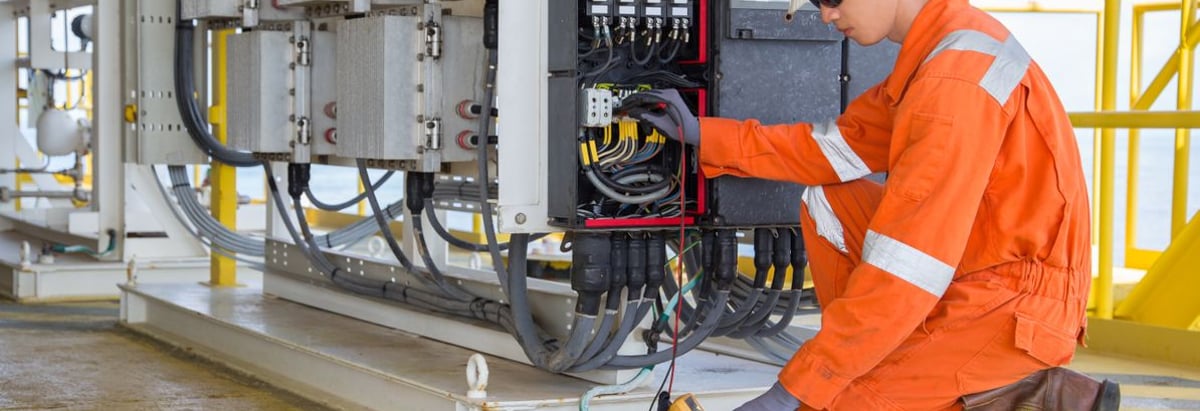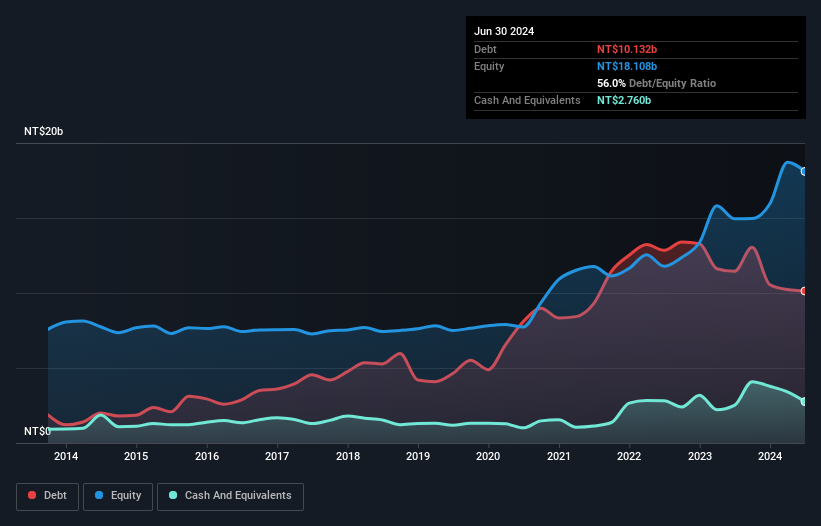- Taiwan
- /
- Electrical
- /
- TWSE:1513
Chung-Hsin Electric and Machinery Manufacturing (TWSE:1513) Has A Pretty Healthy Balance Sheet

The external fund manager backed by Berkshire Hathaway's Charlie Munger, Li Lu, makes no bones about it when he says 'The biggest investment risk is not the volatility of prices, but whether you will suffer a permanent loss of capital.' So it seems the smart money knows that debt - which is usually involved in bankruptcies - is a very important factor, when you assess how risky a company is. As with many other companies Chung-Hsin Electric and Machinery Manufacturing Corp. (TWSE:1513) makes use of debt. But the more important question is: how much risk is that debt creating?
When Is Debt A Problem?
Generally speaking, debt only becomes a real problem when a company can't easily pay it off, either by raising capital or with its own cash flow. If things get really bad, the lenders can take control of the business. However, a more usual (but still expensive) situation is where a company must dilute shareholders at a cheap share price simply to get debt under control. Of course, plenty of companies use debt to fund growth, without any negative consequences. The first thing to do when considering how much debt a business uses is to look at its cash and debt together.
Check out our latest analysis for Chung-Hsin Electric and Machinery Manufacturing
What Is Chung-Hsin Electric and Machinery Manufacturing's Net Debt?
You can click the graphic below for the historical numbers, but it shows that Chung-Hsin Electric and Machinery Manufacturing had NT$10.1b of debt in June 2024, down from NT$11.4b, one year before. On the flip side, it has NT$2.76b in cash leading to net debt of about NT$7.37b.

How Healthy Is Chung-Hsin Electric and Machinery Manufacturing's Balance Sheet?
Zooming in on the latest balance sheet data, we can see that Chung-Hsin Electric and Machinery Manufacturing had liabilities of NT$16.7b due within 12 months and liabilities of NT$13.5b due beyond that. On the other hand, it had cash of NT$2.76b and NT$7.23b worth of receivables due within a year. So its liabilities total NT$20.2b more than the combination of its cash and short-term receivables.
While this might seem like a lot, it is not so bad since Chung-Hsin Electric and Machinery Manufacturing has a market capitalization of NT$85.2b, and so it could probably strengthen its balance sheet by raising capital if it needed to. But we definitely want to keep our eyes open to indications that its debt is bringing too much risk.
We measure a company's debt load relative to its earnings power by looking at its net debt divided by its earnings before interest, tax, depreciation, and amortization (EBITDA) and by calculating how easily its earnings before interest and tax (EBIT) cover its interest expense (interest cover). This way, we consider both the absolute quantum of the debt, as well as the interest rates paid on it.
Chung-Hsin Electric and Machinery Manufacturing's net debt is only 1.4 times its EBITDA. And its EBIT easily covers its interest expense, being 26.3 times the size. So we're pretty relaxed about its super-conservative use of debt. While Chung-Hsin Electric and Machinery Manufacturing doesn't seem to have gained much on the EBIT line, at least earnings remain stable for now. There's no doubt that we learn most about debt from the balance sheet. But ultimately the future profitability of the business will decide if Chung-Hsin Electric and Machinery Manufacturing can strengthen its balance sheet over time. So if you're focused on the future you can check out this free report showing analyst profit forecasts.
But our final consideration is also important, because a company cannot pay debt with paper profits; it needs cold hard cash. So it's worth checking how much of that EBIT is backed by free cash flow. During the last three years, Chung-Hsin Electric and Machinery Manufacturing generated free cash flow amounting to a very robust 85% of its EBIT, more than we'd expect. That puts it in a very strong position to pay down debt.
Our View
Chung-Hsin Electric and Machinery Manufacturing's interest cover suggests it can handle its debt as easily as Cristiano Ronaldo could score a goal against an under 14's goalkeeper. And that's just the beginning of the good news since its conversion of EBIT to free cash flow is also very heartening. Taking all this data into account, it seems to us that Chung-Hsin Electric and Machinery Manufacturing takes a pretty sensible approach to debt. While that brings some risk, it can also enhance returns for shareholders. When analysing debt levels, the balance sheet is the obvious place to start. However, not all investment risk resides within the balance sheet - far from it. These risks can be hard to spot. Every company has them, and we've spotted 2 warning signs for Chung-Hsin Electric and Machinery Manufacturing you should know about.
If you're interested in investing in businesses that can grow profits without the burden of debt, then check out this free list of growing businesses that have net cash on the balance sheet.
If you're looking to trade Chung-Hsin Electric and Machinery Manufacturing, open an account with the lowest-cost platform trusted by professionals, Interactive Brokers.
With clients in over 200 countries and territories, and access to 160 markets, IBKR lets you trade stocks, options, futures, forex, bonds and funds from a single integrated account.
Enjoy no hidden fees, no account minimums, and FX conversion rates as low as 0.03%, far better than what most brokers offer.
Sponsored ContentNew: AI Stock Screener & Alerts
Our new AI Stock Screener scans the market every day to uncover opportunities.
• Dividend Powerhouses (3%+ Yield)
• Undervalued Small Caps with Insider Buying
• High growth Tech and AI Companies
Or build your own from over 50 metrics.
Have feedback on this article? Concerned about the content? Get in touch with us directly. Alternatively, email editorial-team (at) simplywallst.com.
This article by Simply Wall St is general in nature. We provide commentary based on historical data and analyst forecasts only using an unbiased methodology and our articles are not intended to be financial advice. It does not constitute a recommendation to buy or sell any stock, and does not take account of your objectives, or your financial situation. We aim to bring you long-term focused analysis driven by fundamental data. Note that our analysis may not factor in the latest price-sensitive company announcements or qualitative material. Simply Wall St has no position in any stocks mentioned.
About TWSE:1513
Chung-Hsin Electric and Machinery Manufacturing
Chung-Hsin Electric and Machinery Manufacturing Corp.
Undervalued with solid track record and pays a dividend.
Similar Companies
Market Insights
Community Narratives



